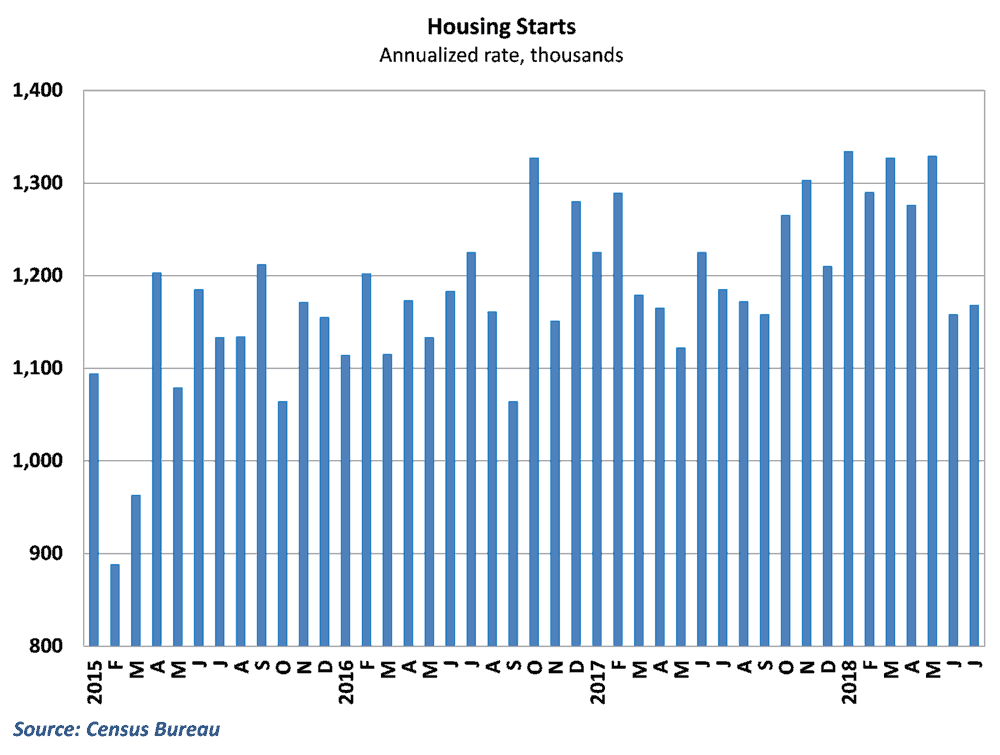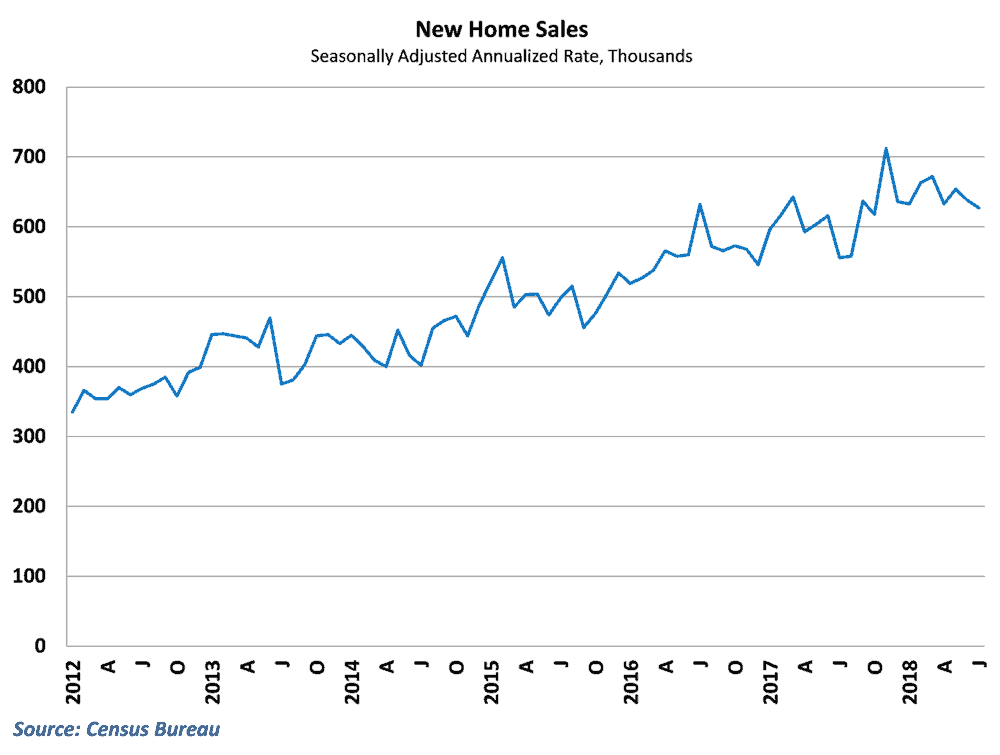A package of weak data on both housing starts and home purchases indicates that housing and construction remains one of the few areas of weakness in the economy in the 3rd quarter. This has put some downward pressure on freight demand, as the movement of building materials, furniture, and appliances is influenced by the strength of the housing market.
Scarcity of labor, land have restricted the housing supply
Earlier this month, the Census Bureau reported that housing starts rebounded mildly in July, advancing to a 1,168,000 annualized pace after a large downwardly-revised decline in June. This fell well short of consensus expectations of a 1,271,000 pace, and combined with June’s downgrade show that the construction sector has weakened significantly throughout 2018.
This is particularly disappointing because the housing sector looked to be gathering momentum headed into the year. The 4th quarter of 2017 saw a boost in activity from rebuilding efforts following the especially rough hurricane season, and housing starts generally accelerated over the last several months of the year. However, home starts have failed to gain any further since January, and have been negative year-over-year following June’s big decline.

Part of the reason for the disappointment in housing starts has been the rising costs for construction materials. Prices for lumber skyrocketed earlier this year after Canadian supply disruptions and US tariffs on lumber imports. This, in turn, has raised the cost for builders. However, lumber and materials prices have come down after peaking a couple months ago, and new home construction continues to struggle.
Home builders have also struggled with a lack of developed lots for building. This shortage of available lots for construction means that prospective home builders have to pay more for the limited supply available. This adds to the costs of building new homes, and further contributes to the disappointing building activity in 2018.
In addition, like much of the rest of the economy construction companies have struggled with finding skilled labor. The number of job openings within the construction industry has soared to the highest level in over a decade, with builders looking to add over a quarter of a million workers over the next year. Hiring has been fairly strong so far in 2018, but there remains a significant shortage in the industry, which is further limiting the supply of homes on the market.
Demand for new homes faces rising mortgage rates, affordability issues
Home sales have also sputtered in recent months, as buying activity has essentially stalled in the 2nd and 3rd quarters. The Census Bureau reported late last week that new home sales declined for the second straight month in July, falling to a 627,000 annualized pace. Like home starts, this fell well short of consensus expectations of a 649,000 pace and marks the third monthly decline in four months for new home purchases.
Existing home sales, which make up the majority of home purchases, have fared no better. The National Association of realtors reported last week that sales of previously owned homes fell for the fourth consecutive month in July, falling 0.6% to a 5,340,000 annualized pace. Existing home sales are now almost 2.5% lower than at this point last year, and are trending towards declining for 2018 overall.

These results are particularly disappointing because many of the fundamentals for home buying are moving in a positive direction. Job growth remains robust in the economy, which has supported solid income growth throughout 2018. In addition, households received a reduction in personal income taxes as part of the Tax Cuts and Jobs Act put into place at the start of the year. These conditions led many (including myself) to believe that housing was ready to contribute in a big way to overall economic performance this year.
Of course, part of the problem with new home sales goes back to the issues with new home starts. If there aren’t enough new homes being built, then purchases are bound to struggle as prices rise from the limited supply. The upward pressure on prices then leads owners of existing houses, who may have considered offering their homes for sale, to hold on to their properties longer. This behavior further restricts the housing supply and affects the overall affordability of housing in the economy.
In addition, mortgage rates have generally increased in the economy since the start of the year, rising by about a half of a percentage point since the start of the year. This also makes home buying more difficult, as rising rates lead to higher monthly payments for prospective buyers.
Lastly, while the tax law passed at the start of the year provides some boost to household income, there were also provisions in the tax bill that limited the amount of mortgage interest that can be deducted from taxable income. This, in effect, reduces the incentive for owning more expensive homes and may be playing a role in reducing the overall demand for new homes..
Housing market and freight demand
Activity in the housing market plays a key role in overall freight demand in the economy. Construction materials account for approximately 5% of all ton-miles in the economy, and the disappointing results from home building will reduce the demand for flatbed carriers and other modes of transporting construction materials.
Home sales, on the other hand, typically affect demand for associated goods. Rising home sales and homes offered for sale often provide a benefit for building materials and gardening equipment, as owners spend on remodeling and landscaping efforts. In addition, heavy consumer durable goods like furniture, air conditioning units, refrigerators, and stoves (known as “white goods” for their traditional finish) typically see a lift from rising home sales. This drives freight movements to ship these items to and from warehouses and distribution centers. In addition, these white goods sales have increasingly opened up to e-commerce channels in recent years, helping to drive some of the growth in last-mile delivery services for truckers and LTL carriers.
Going forward, there are still good reasons to believe that housing activity will pick up in the remainder of the year. For one, construction material prices have come down and the recent strength in construction hiring should eventually translate into new production of homes. Consumer conditions remain generally strong, so when new homes come into the market, buyers will likely be waiting even with higher mortgage rates. Still, affordability is expected to remain an issue going forward, and even if housing market improves, it is likely to be well below the pace many expected at the start of the year.
Ibrahiim Bayaan is FreightWaves’ Chief Economist. He writes regularly on all aspects of the economy and provides context with original research and analytics on freight market trends. Never miss his commentary by subscribing.










